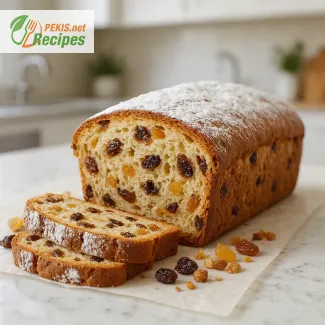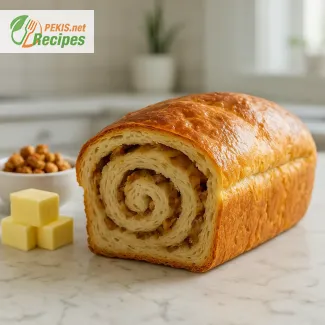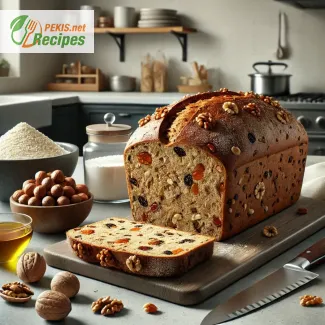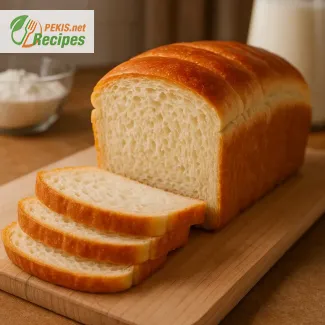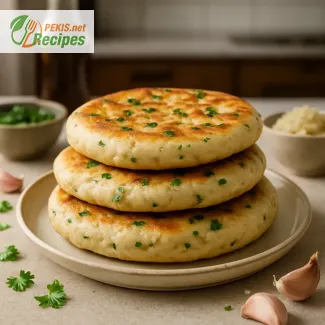
Celebrate Easter with a Traditional German Braided Bread Delight
A festive sweet bread wreath that symbolizes spring, rebirth, and joyful gatherings
There’s something magical about the arrival of spring — longer days, blooming flowers, and the anticipation of Easter celebrations. Among the most cherished culinary traditions of the season is the German Osterkranz, a sweet braided Easter bread shaped like a wreath. This visually stunning centerpiece is more than just a treat — it’s a symbol of life, renewal, and familial warmth, passed down through generations and lovingly baked in kitchens across Germany and beyond.
The Osterkranz, often adorned with pastel-colored eggs or delicate sugar glazes, is the epitome of Easter baking. Its tender, enriched dough, gently flavored with hints of lemon zest, vanilla, and a touch of cardamom, offers a fragrant and comforting aroma that fills the home. The braided shape, woven into a ring, isn’t just for show — it represents unity and continuity, making it a meaningful addition to your Easter table.
Whether you’re hosting a festive brunch, looking for a thoughtful homemade gift, or simply craving a slice of something warm and nostalgic, this Easter bread never fails to impress. Traditionally, it’s served during Easter Sunday breakfast or brunch, often enjoyed with butter, fruit preserves, or even lightly toasted with a bit of honey. Some families place decorated hard-boiled eggs in the center of the wreath as part of the table display, making it not only delicious but also an eye-catching part of the holiday décor.
The dough itself is an enriched yeast dough, made with milk, butter, sugar, and eggs, resulting in a light and fluffy texture that melts in your mouth. Its golden crust, brushed with egg wash before baking, gives it a shiny, inviting finish. A final dusting of powdered sugar or a drizzle of vanilla glaze adds the perfect touch of sweetness.
One of the many beauties of the Osterkranz is its versatility. While the classic version is plain or lightly sweetened, some bakers choose to fill the braids with ingredients like almond paste, raisins soaked in rum, or dried fruits. Others like to add a modern twist with chocolate chips or orange zest for a citrusy kick. No matter the variation, the heart of this bread remains the same — it’s about celebration, tradition, and bringing people together.
What sets this Easter wreath bread apart from other springtime bakes is the experience of crafting it by hand. Braiding the dough, shaping it into a ring, and watching it rise into a golden crown of celebration is deeply rewarding. It’s a joyful baking project that invites participation from the whole family, including little hands eager to help twist the strands or decorate the final result.
If you’ve never made a braided bread before, don’t worry — with a bit of patience and some clear guidance, the process is surprisingly easy and thoroughly enjoyable. As the sweet scent of baking bread wafts through your kitchen, you’ll know something special is on its way.
This recipe is more than a list of ingredients and instructions — it’s a culinary ritual that embodies Easter traditions in German households. From its symbolic shape to its irresistible taste, the Osterkranz captures the spirit of the season in every golden slice.
In the sections that follow, you’ll learn how to make this beloved Easter bread from scratch, including tips for kneading, braiding, and customizing it to your taste. Whether you stick with the classic version or add your personal flair, one thing is certain — this Osterkranz will become a beloved part of your springtime celebrations for years to come.
Let’s dive into the recipe and explore how you can recreate this beautiful and flavorful Easter wreath bread in your own kitchen.
1. Prepare the yeast mixture:
Warm the milk (250 ml / 1 cup) until lukewarm (not hot). In a small bowl, dissolve the yeast (21 g fresh or 7 g dry) in the milk with 1 tablespoon of the measured sugar. Let it sit for 10–15 minutes until foamy.
2. Make the dough:
In a large mixing bowl, combine the flour (500 g / 4 cups), remaining sugar (approx. 60 g / ¼ cup), salt (1 g / ¼ tsp), vanilla sugar or extract, cardamom, and lemon zest. Add the foamy yeast mixture, eggs (2), and softened butter (80 g / ⅓ cup). Knead the dough using a stand mixer with a dough hook or by hand for about 10 minutes until smooth and elastic. If using raisins, fold them in now.
3. First rise:
Shape the dough into a ball, place it in a lightly oiled bowl, cover with a clean towel, and let it rise in a warm place for 60 minutes or until doubled in size.
4. Braiding the dough:
Punch down the risen dough and divide it into 3 equal parts. Roll each part into a rope about 40 cm (16 inches) long. Braid the three ropes together tightly. Then shape the braid into a circle (wreath) and pinch the ends to seal.
5. Second rise:
Place the wreath on a baking sheet lined with parchment paper. Cover with a towel and let it rise again for 30 minutes.
6. Preheat the oven:
Preheat the oven to 180°C (350°F).
7. Brush and bake:
Mix the egg yolk with 1 tablespoon of milk. Brush the entire surface of the dough. Bake in the preheated oven for 25–30 minutes or until golden brown. If it browns too quickly, loosely cover with foil in the last 10 minutes.
8. Add the glaze:
Let the baked wreath cool completely. In a small bowl, mix the powdered sugar (60 g / ½ cup) with lemon juice (15 ml / 1 tbsp) until smooth. Drizzle over the cooled wreath. Decorate with sugar eggs or sprinkles if desired.
A Timeless Easter Tradition: Discover the Joy of Braided Sweet Bread
An authentic German celebration wreath made with love and springtime flavors
Every culture has its own treasured traditions for celebrating the arrival of spring, and in Germany, few Easter customs are as cherished or as visually stunning as the Osterkranz — a sweet braided bread wreath that graces festive tables with its elegant form and heartwarming flavors. This beautiful Easter bread, braided by hand and often adorned with soft glazes or colorful eggs, carries a sense of joy, heritage, and rebirth, making it more than just a seasonal dessert — it's a symbol of togetherness.
The German Osterkranz is a soft, lightly sweetened bread made with an enriched yeast dough, similar in style to challah or brioche, yet uniquely flavored with lemon zest, vanilla, and a whisper of cardamom. Its golden, glossy crust contrasts perfectly with its tender, airy interior — a balance that has made it a beloved centerpiece for Easter breakfasts and brunches throughout generations.
One of the most striking aspects of the Osterkranz is its braided wreath shape, which is as symbolic as it is decorative. The circular form represents eternity and the cycle of life, while the braid reflects the interweaving of tradition, family, and celebration. Whether placed in the center of the holiday table or gifted to loved ones as a homemade token of spring’s renewal, this bread delivers both flavor and sentiment.
During Easter in many German households, it’s common to serve the Osterkranz with a selection of butters, fruit preserves, or even soft cheeses, complementing its subtle sweetness with contrasting textures and flavors. Sometimes, hard-boiled, dyed eggs are nestled into the braids before baking or placed in the center afterward, making the bread not just a culinary treat but also a decorative focal point.
Making this bread at home is a satisfying ritual. The process of kneading the dough, watching it rise, braiding it with care, and finally baking it into golden perfection offers a deep sense of connection — not only to cultural heritage but also to the comforting rhythm of homemade baking. It’s a wonderful recipe to share with children or family members, offering a moment of togetherness as each strand is twisted into place.
What makes this bread especially versatile is how adaptable it can be. While the classic Osterkranz is flavored simply and elegantly, variations abound. Some bakers prefer to add raisins soaked in rum, while others might incorporate orange zest, chopped almonds, or even a touch of cinnamon. For a more modern flair, small bits of dark chocolate or candied citrus peel can be added to the dough. Regardless of the filling or garnish, the essence of the bread remains: it is joyful, generous, and rooted in tradition.
The final touch of a delicate lemon glaze, poured over the cooled bread, adds a hint of tangy brightness that contrasts beautifully with the warm notes of vanilla and spice. Some versions are sprinkled with pearl sugar or pastel sprinkles, especially when made for festive gatherings. Others are left plain and elegant, allowing the intricate braiding and natural golden sheen to shine.
Whether you’re new to Easter baking or looking to add an authentic German touch to your springtime celebrations, this recipe offers more than just delicious results. It offers an experience — one filled with aromas, textures, colors, and stories that have been shared across generations. The Osterkranz is not only an invitation to bake but also to reflect, connect, and celebrate the joy of seasonal renewal.
In the following sections, you’ll learn how to make this festive bread step by step, from mixing and kneading the dough to braiding it into its signature shape. Along the way, we’ll also explore variations and helpful tips that will make your Easter baking smoother and more rewarding.
Get ready to embrace a piece of culinary heritage that brings families together, transforms kitchens into places of warmth and tradition, and adds a golden crown of celebration to your holiday table.
Contains gluten (wheat), eggs, milk (lactose).
Substitution tips:
- For a gluten-free version, use a gluten-free flour blend with added xanthan gum and adjust liquid accordingly.
- For a dairy-free option, substitute milk with plant-based alternatives (like almond or oat milk) and use dairy-free margarine instead of butter.
- For an egg-free alternative, replace each egg with 60 g (¼ cup) of unsweetened applesauce or use commercial egg replacers.
- Vitamin B1 (Thiamine): 0.16 mg – supports energy metabolism and nerve function
- Vitamin B2 (Riboflavin): 0.18 mg – essential for cellular function
- Vitamin B12: 0.3 µg – important for red blood cell production
- Calcium: 40 mg – contributes to bone health
- Iron: 1.2 mg – supports oxygen transport
- Magnesium: 12 mg – assists muscle and nerve function
- Phosphorus: 65 mg – essential for energy metabolism
- Potassium: 70 mg – helps regulate fluid balance
- Zinc: 0.5 mg – supports immune function
- Vitamin E: 0.5 mg – protects cells from oxidative stress
- Selenium: 5 µg – neutralizes free radicals and supports thyroid function
- Lutein & Zeaxanthin: trace – support eye health
- Beta-Carotene: trace – supports immune response and skin health
This festive bread not only brings tradition and warmth to your Easter celebration, but also contributes to your well-being with essential nutrients and beneficial compounds.
